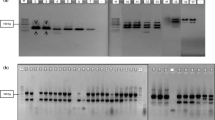Abstract
North Pacific flatfishes are gaining increased popularity on the German market. Isoelectric focusing of sarcoplasmic proteins and PCR-based DNA analysis were applied to identify fillets of nine Alaskan Flatfish species: Artheresthes stomias (Arrow-tooth flounder), Limanda aspera (Yellowfin sole), Isopsetta isolepis (Butter sole), Lepidopsetta bilineata (Southern rock sole), Lepidopsetta polyxystra (Northern rock sole), Hippoglossus stenolepis (Pacific halibut), Hippoglossoides elassodon (Flathead sole), Platichthys stellatus (Starry flounder), and Glyptocephalus zachirus (Rex sole). Characteristic protein patterns were obtained for raw fillets of several species. Reactivity of flatfish DNA against five pairs of primers was tested, amplifying segments of the mitochondrial cytochrome b, cytochrome oxidase subunit I, 16S rRNA gene, as well as the nuclear parvalbumin gene. Amplicons of the cytochrome b gene were sequenced and used for single-strand conformation polymorphism analysis. The survey of deep-frozen commercial yellowfin sole fillets resulted in the detection of 17% of the fillets being mislabelled; Northern rock sole, butter sole and flathead sole had been used as substitutes.





Similar content being viewed by others
References
Rehbein H (2008) New fish on the German market: consumer protection against fraud by identification of species. J Verbr Lebensm 3:49–53
Fisch-Informationszentrum (2010) Fischwirtschaft—Daten und Fakten 2010. http://www.fischinfo.de
Greenpeace (2010) Greenpeace International Seafood Red List. http://www.greenpeace.org/international/seafood
Environmental Defense Fund (2010) Seafood Selector. http://www.edf.org
Marine Stewardship Council (2011) http://www.msc.org
National Oceanographic Atmosphere Organization (2011) Fisheries service report, total IFQ landings & pounds by port for fishing year 2010. http://www.fakr.noaa.gov/ram/10ifqport.htm
Turnock BJ, Wilderbuer TK, Brown ES (2005) GOA Flatfish. In: NPFMC Gulf of Alaska SAFE. http://www.afsc.noaa.gov/refm/docs/2005/GOAflat.pdf
Federal Agency for Agriculture and Food (2011) List of market names of products from fisheries and aquaculture (in German: Verzeichnis der Handelsbezeichnungen für Erzeugnisse aus Fischerei und Aquakultur). http://www.ble.de
Alaska Fisheries Development Foundation (2010) Flatfish quality evaluation project. Flatfish handling, processing and marketing project. http://www.afdf.org
Boiselle C (2010) Von der Kliesche, die auszog eine „echte Rotzunge“zu werden. http://www.lebensmittelkontrolle.de
Espineira M, Gonzalez-Lavin N, Vieites JM, Santaclara FJ (2008) Development of a method for the genetic identification of flatfish species on the basis of mitochondrial DNA sequences. J Agric Food Chem 56:8954–8961
Norman JR (1934) A systematic monograph of the flatfishes (Heterosomata). Vol 1: Psettodidae, Bothidae, Pleuronectidae, British Museum (Natural History), London, UK
Rehbein H, Kündiger R (1984) Comparison of the isoelectric focusing patterns of sarcoplasmic proteins from red and white muscle of various fish species. Archiv für Fischerei-Wissenschaft 35:7–16
Altinelataman C, Kündiger R, Cakli S, Rehbein H (2009) Comparison of IEF patterns of sarcoplasmic proteins of fish from North Atlantic and Aegean Sea. Food Control 20:980–985
Rehbein H, Kreß G (2005) Detection of short mRNA sequences in fishery products. Deutsche Lebensmittel-Rundschau 101:333–337
Wolf C, Burgener M, Hübner P, Lüthy J (2000) PCR-RFLP analysis of mitochondrial DNA: differentiation of fish species. Lebensm Wiss Technol 33:144–150
Ward RD, Zemlak TS, Innes BH, Last PR, Hebert PDN (2005) DNA barcoding Australia’s fish species. Phil Trans R Soc B 360:1847–1857
Pardo BG, Machordom A, Foresti F, Porto-Foresti F, Azevedo MFC, Banon R, Sanchez L, Martinez P (2005) Phylogenetic analysis of flatfish (Order Pleuronectiformes) based on mitochondrial 16 s rDNA sequences. Sci Marina 69:531–543
Rehbein H (2007) Differentiation of hake species by RFLP- and SSCP-analysis of PCR amplified cytochrome b and parvalbumin sequences. Deutsche Lebensmittel-Rundschau 103:511–517
Sun M, Liang C, Gao H, Lin C, Deng M (2009) Detection of parvalbumin, a common fish allergen gene in food, by real-time polymerase chain reaction. JAOAC Intern 92:234–240
Schiefenhövel K, Rehbein H (2011) Identification of barramundi (Lates calcarifer) and tilapia (Oreochromis spp.) fillets by DNA- and protein analytical methods. J Verbr Lebensm 6:203–214
Bavarian Health and Food Safety Agency (Bayerisches Landesamt für Gesundheit und Lebensmittelsicherheit). http://www.lgl.bayern.de
Rehbein H (2009) Protein-based methods. In: Rehbein H, Oehlenschläger J (eds) Fishery products-quality, safety and authenticity. Wiley-Blackwell, Chichester, pp 349–362
Rasmussen RS, Morrissey MT (2008) DNA-based methods for the identification of commercial fish and seafood species. Compr Rev Food Sci Saf 7:280–295
Rehbein H, Schiefenhövel K (in press) Evaluation of a rapid PCR-based method for species identification of raw and processed fish and shrimps. J Aqua Food Prod Technol
Ratnasingham S, Hebert PD (2007) BOLD the barcode of life data system (http://www.barcodinglife.org). Mol Ecol Notes 7:355–364
Yancy HF, Zemlak TS, Mason JA, Washington JD, Tenge BJ, Nguyen NT, Barnett JD, Savary WE, Hill WE, Moore MM, Fry FS, Randolph SC, Rogers PL, Hebert PDN (2008) Potential use of DNA barcodes in regulatory science: applications of the Regulatory Fish Encyclopedia. J Food Prot 71:210–217
Kartavtsev YP, Sharina SN, Goto T, Chichvarkhin AY, Balanov AA, Vinnikov KA, Ivankov VN, Hanzawa N (2008) Cytochrome oxidase 1 gene sequence analysis in six flatfish species (Teleostei, Pleuronectidae) of Far East Russia with inferences in phylogeny and taxonomy. Mitochondrial DNA 19:479–489
Roje DM (2010) Incorporating molecular phylogenetics with larval morphology while mitigating the effects of substitution saturation on phylogeny estimation: a new hypothesis of relationships for the flatfish family Pleuronectidae (Percomorpha: Pleuronectiformes). Mol Phylogen Evol 56:586–600
Kijewska A, Burzynski A, Wenne R (2009) Molecular identification of European flounder (Platichthys flesus) and its hybrids with European plaice (Pleuronectes platessa). ICES J Marine Sci 66:902–906
Hildebrandt S (2010) Multiplexed identification of different fish species by detection of parvalbumin, a common fish allergen gene: a DNA application of multi-analyte profiling (xMAPTM) technology. Anal Bioanal Chem 397:1787–1796
Acknowledgments
The skilful technical assistance of Mrs. R. Koch and Mr. R. Kündiger is gratefully acknowledged.
Author information
Authors and Affiliations
Corresponding author
Rights and permissions
About this article
Cite this article
Rehbein, H., Oliveira, A.C.M. Alaskan flatfishes on the German market: part 1: identification by DNA and protein analytical methods. Eur Food Res Technol 234, 245–251 (2012). https://doi.org/10.1007/s00217-011-1629-z
Received:
Revised:
Accepted:
Published:
Issue Date:
DOI: https://doi.org/10.1007/s00217-011-1629-z




